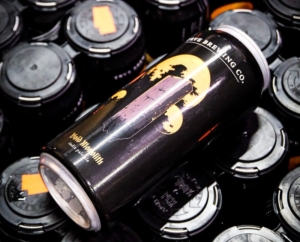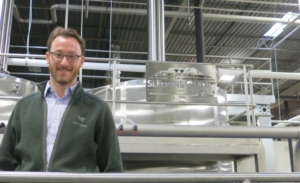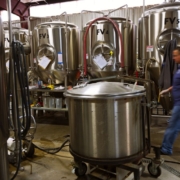As craft brewers grapple with a beer recession, less is more as new business models beckon
America’s craft brewers would have been forgiven earlier this month for looking awry at a recurring headline in the Wall St. Journal: Why the Recession Still Isn’t Here might continue to describe macro conditions, but for much of the local suds industry, a deep downturn — a beer recession — has been a harsh reality for some time.
“It sucks,” deadpanned Eric Wallace, co-founder of Colorado craft first-mover Left Hand Brewing Company. I caught up with Wallace at Left Hand’s sparkling new restaurant and taproom in Denver’s bustling RiNo district, an ironic place to be discussing craft beer’s current struggles. It teases exciting new possibilities.
Yet for Wallace and others who upset convention with brash new ideas, it often begins and ends with beer, and the industry wreckage today has dampened enthusiasm for what lies ahead. Breweries too many to count have shuttered, and some of the industry’s most established operators have backed up. COVID, inflation, and a market flooded with a seemingly endless roster of inventive beers have proved more formidable than Big Beer.
Wallace considers what his own innovation ethos has wrought. “We helped bring this on,” he offers. “We have innovated and pushed the boundaries of beer to a point where not only are our customers and beer drinkers confused, but I’m confused. It feels a bit like the first shake out back in the late 90’s and early aughts. Lots of beer on the shelves of questionable quality with very short functional shelf life, and lots of gateway inventions leading our customers away from beer, not into beer. There are so many brands on the shelf that you need good fortune’s help to make a decision on what to actually try, hoping to not get burned.”

As a result, he sees consolidation as pretty inevitable. “We have an overbuilt brewing environment and until some of the excess capacity is transitioned out of the marketplace, margins will suffer, and brands will perish.”
Fewer brands would certainly refocus consumers. But even if Left Hand’s stellar brands like Milk Stout Nitro and Sawtooth lead a beer comeback, the appetite to diversify, like Left Hand’s RiNo restaurant and bar, is industry-wide and seems here to stay.
Nick Nunns gained a craft foothold with TRVE Brewing Company with a reputation for making great beer but also with a unique brand: TRVE’s connection with Denver’s ‘heavy metal’ scene not only informed the vibe at its downtown location but also its retail presence. Nunns also wasn’t eager to get big, fast.
“Our tap room numbers haven’t changed,” Nunns told me, “We’re certainly seeing a slight decline in wholesale year over year, but it’s nothing I’m panicked about. I think it’s just the downturn of the industry overall. Given my personal experience, I can understand where the consumer is at, having less purchasing power overall,” he added.
Nunns has also kept the brewery in motion. “TRVE has always been a brewery that has done pivot after pivot after pivot. Sour beer took a downturn, so we pivoted, you know, and we started boosting production for the wholesale market of a lot of our clean beers — like IPAs and lagers. We’ve been told we were doing craft lagers before they were cool.”
And for Nunns, it’s no longer just about just making beer. “I was getting a little tired of ‘The Lonely Island of Denver,’ you know, just being so far from literally anywhere else was just starting to feel very restrictive and isolating.”
So, Nunns made the ultimate pivot — and acquired a brewpub in Asheville, North Carolina. He’s from the East Coast originally. “My wife has had ties in Asheville for quite some time, and through the process of us dating long distance, I just started visiting Asheville fairly regularly.”
Like Left Hand, TRVE made the jump into the restaurant business — but half a continent away. “We’ve established a wine list, a cocktail program, thanks to some collaboration with a group of folks who are trying to look into opening their own bar. And we’re doing like, pop up bars, you know, around Asheville. Obviously, our licensing is a little bit more flexible here, doing business as a brewery.”
“We’re really shifting what we’re doing,” he adds, “at least here in North Carolina, into more of an on-premise business model where it’s really just about running a brewpub more than it is about, like, trying to find placements (for beer) in liquor stores and bars and all that stuff because there’s just not as much money left in that anymore.”

Nunns’ has also outsourced production to New Image Brewing, nearby in Arvada, Colorado. It’s a move that might have been a death-knell for a craft brewers’ reputation a decade ago, but as craft has matured and effectively won its battle with Big Beer, feels like an evolution of sorts.
“It was really just us reading the room and saying, ‘Why are we struggling in a production facility that’s never really going to be an efficient setup,’ and at the same time, New Image was looking for partners to bring in because they had a building and facility that’s set-up for bringing in more beer, more production. All we needed was tanks,” Nunns explains, “so it was literally just moving some of our equipment over to their location, without us having to cut any corners or affect our recipes or the ethos of how we go about making beer. All of those things are easily maintained.”
Contract production — co-manufacturing — isn’t new to craft. Denver’s Sleeping Giant Brewing Company was a first mover in the space. Founder Matt Osterman has been helping brands manufacture at scale since 2015 and, today, is making beer for brands across the West. But more, he has a growing interest in the beyond-the-beer category. The stainless-steel tanks in Osterman’s Denver factory cater to a diverse, fast-changing beverage market.
Beer was first for Sleeping Giant, and the connection remains strong. “Beer is what our facility is designed for, and that is what our team is built around. Beer is certainly the lifeblood of what we do,” he says.
That said, the beer recession seems to be forcing every operator to reconsider its path. With a slowdown leaving more and more empty stainless-steel in the market, brewers are evaluating new ways to fill ‘em up.
“I mean, it’s been interesting. Or I could make it a bit more dramatic and say that we’ve seen not just other breweries get into the space, but brands that were actually clients or prospective clients of ours that today have become co-packers,” Osterman says. “So, it’s not just the more competitive landscape, it’s that the pool of prospective clients has shrunk and the amount of suppliers has grown. It’s interesting for sure.”
But it’s not more beer that’s capturing the imagination of brewers; after all, there’s already so much beer on the market. Today, it’s ready-to-drink cocktails, a dizzying array of hard teas and kombuchas, spiked seltzers and straight-up canned drinks, and everything in between.

“A lot of breweries are making things that aren’t traditional craft beer right now, and we’re talking the big kids — like Sierra Nevada, New Belgium, Boston Beer Co. — the ones that have been around for a long time, the ones that are arguably the most successful companies from a business standpoint.” Osterman says.
“Sierra Nevada’s got this whole new innovation production space that they’re doing, and it’s clear that they are leaning into this space and understand that they’re not going to conquer the future with the same things that they’ve done in the past.”
I asked Osterman if he’s leaning in by necessity, given craft beer’s challenges, or simply because opportunity beckons.
“The diversification that we’re doing is intentional,” he answers, “in part because, honestly, it makes us a healthier, more well-rounded company. I continue to believe in the [beer] space, but I think that it would be foolish not to recognize some of the segmenting that’s going on, and some of the diversification that will keep happening, especially the more that we get influenced by Gen Z. The upcoming target demos don’t want the same thing that their predecessors have had.”
Eric Wallace has lived the entire arc of the craft brewing experience. “We survived the first shake out by merging with Tabernash Brewing Company in 1998 — in the old Denargo Market back then — and then starting up our own distribution company (Indian Peaks Distributing) in 1999,” he says. “We had to cut, scrimp, shuck, jive and raise capital to get through it. Today, we’ve now brought on a number of co-packing partners in the distilling, hard kombucha, CBD seltzer, and beer businesses — and will be bringing on others as well. We’re all going to have to find ways to keep our breweries busy and work our way through this next shake out. And it’s easier said than done.”
That may be, but from each setback, craft purveyors have indeed shucked and jived their way to sustained success. It may look different on the other side, less may be more, but there’s little doubt the next craft industry iteration will again fly high.
Bart Taylor is a Moss Adams BDE and contributor to MFG Insider. Reach him at bart.taylor@mossadams.com.

